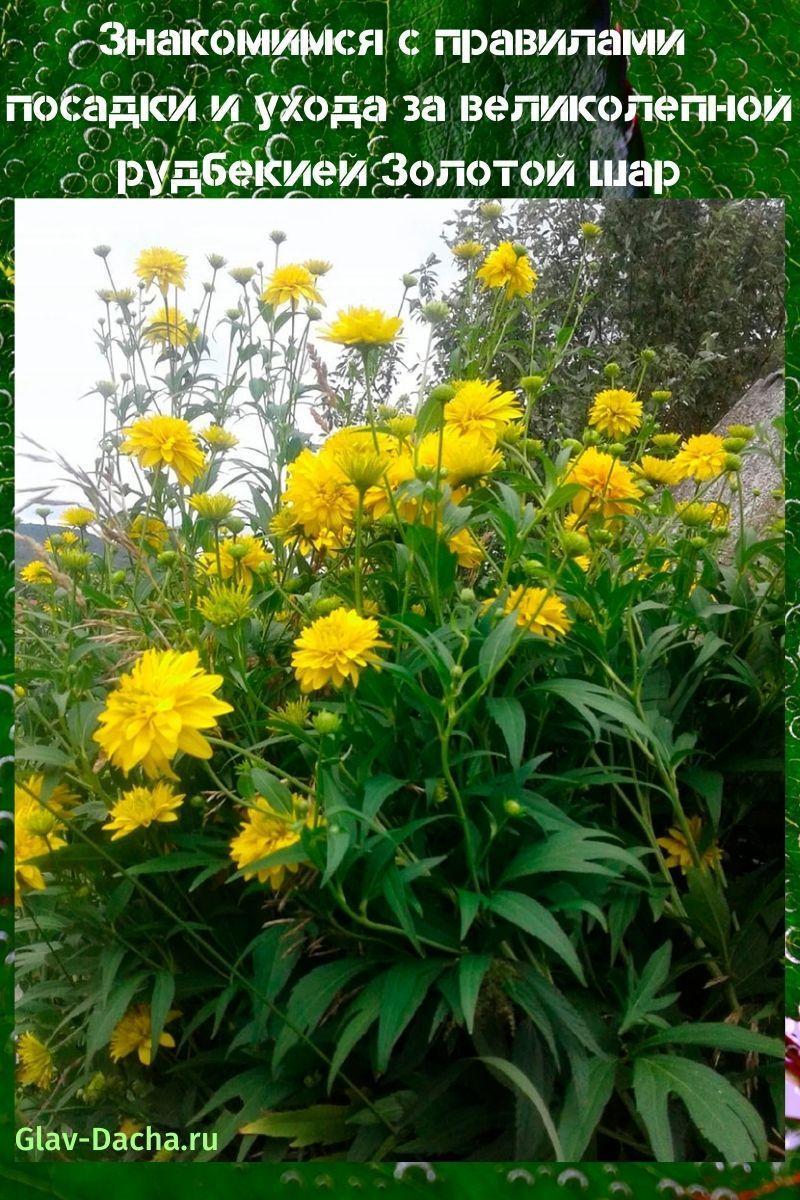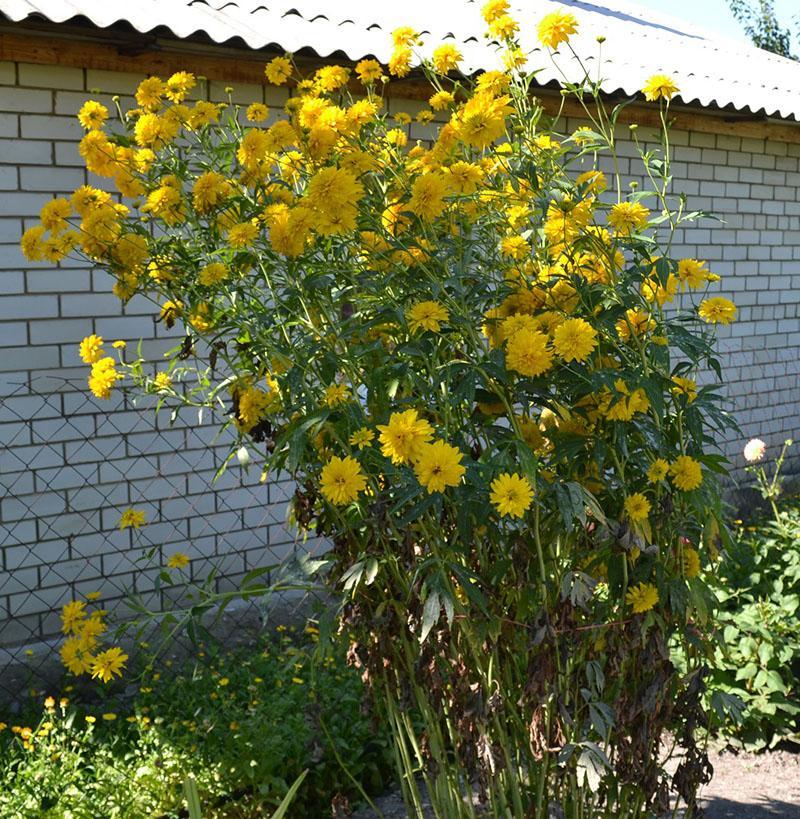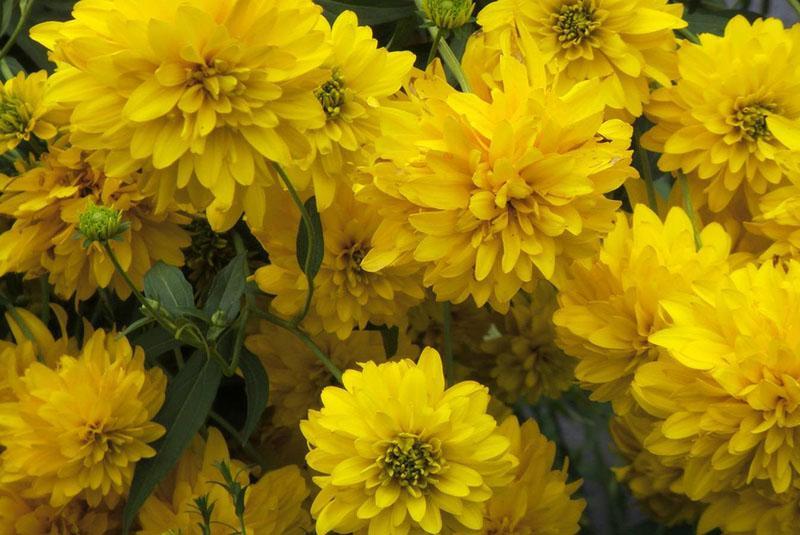Get acquainted with the rules of planting and caring for the magnificent rudbeckia Golden ball
 Who is this charming tall blonde in the neighbor's front garden - you ask, walking along the dacha street. And over there she coquettishly peeks out from behind the fence, flaunting wonderful golden curls and this is a charming rudbeckia Golden ball. Planting and caring for rudbeckia Golden ball in the garden is not difficult and everyone can do it. And then the red-haired beauty will settle in your garden, every summer delighting with placers of sunny inflorescences against the background of dense emerald greenery.
Who is this charming tall blonde in the neighbor's front garden - you ask, walking along the dacha street. And over there she coquettishly peeks out from behind the fence, flaunting wonderful golden curls and this is a charming rudbeckia Golden ball. Planting and caring for rudbeckia Golden ball in the garden is not difficult and everyone can do it. And then the red-haired beauty will settle in your garden, every summer delighting with placers of sunny inflorescences against the background of dense emerald greenery.
Getting to know the plant

 Rudbeckia inflorescences are baskets 10–12 cm in diameter, composed of pale yellow tubular flowers and bordered by golden yellow reed flowers. Flowering begins in June and lasts up to two to three months.
Rudbeckia inflorescences are baskets 10–12 cm in diameter, composed of pale yellow tubular flowers and bordered by golden yellow reed flowers. Flowering begins in June and lasts up to two to three months.
Rudbeckia dissected Golden ball favorably differs by a longer flowering period. The plants grow in bud in early July and bloom continuously until frost.
 This is the tallest variety of rudbecky - shoots often reach two or more meters.
This is the tallest variety of rudbecky - shoots often reach two or more meters.
Features of growing rudbeckia Golden ball
 Rudbeckia dissected is considered an unpretentious flower. It is grown on any soil, excluding too moist and dense clayey. It is distinguished by a branched horizontal rhizome, which grows rapidly, filling all the free space. Therefore, a flower bed with "golden balls" is separated from other plants by boards or slate. The fence is dug in to a depth of 15–20 cm.
Rudbeckia dissected is considered an unpretentious flower. It is grown on any soil, excluding too moist and dense clayey. It is distinguished by a branched horizontal rhizome, which grows rapidly, filling all the free space. Therefore, a flower bed with "golden balls" is separated from other plants by boards or slate. The fence is dug in to a depth of 15–20 cm.
In one place, rudbeckia grows up to 10 years, subject to good care. So that the plantation of "golden balls" does not lose its attractiveness, the bushes are tied up, trying to place them at some distance from each other.
In summer cottages with thickets of rudbeckia, they decorate the blank walls of sheds, fences, planted in front gardens, frame gazebos... Behind the bright yellow wall of "golden balls" it is easy to hide an unpresentable compost bin or a pile of materials left over from construction work.
How to propagate Rudbeckia Golden Balls vegetatively
 The easiest way to breed a long-legged beauty in your area is to divide the root into several parts.
The easiest way to breed a long-legged beauty in your area is to divide the root into several parts.
In late summer or early autumn, the plants are completely cut off at a height of 20-30 cm. Then:
- the overgrown bush is completely dug up;
- with a sharp shovel or knife, divide the rhizome into several parts;
- cuts are sprinkled with crushed coal;
- cuttings are planted in pre-prepared planting holes, sprinkled with earth and watered abundantly.
Before the onset of persistent cold weather, plantings are covered with spruce branches, hay or dry compost.
Planting pits are prepared as follows:
- a layer of sand and drainage is poured onto the bottom;
- prepare a bucket of fertile soil from compost, sand, a tablespoon of superphosphate and potassium salt and mix well;
- half of the prepared soil is poured into the pit and spilled with water.
After 2-3 weeks, the soil in the hole will settle and it will not be difficult to plant the root section at the correct height - at soil level.The newly planted plant is sprinkled with the rest of the soil, the earth is compacted so that the roots are not exposed. In the spring, the shelters are removed from the young bushes, the ground around is carefully loosened.
By dividing the root, only healthy bushes that are overgrown are propagated. If the plants look sick, it is better to propagate the "golden ball" rudbeckia with seeds. Before sowing, they are easy to pickle with any fungicide.
Planting and caring for rudbeckia Golden ball of seeds
 Seedlings obtained from quality seeds bloom in 1–2 years. With proper care, plants grow strong and healthy, without signs of degeneration of the variety.
Seedlings obtained from quality seeds bloom in 1–2 years. With proper care, plants grow strong and healthy, without signs of degeneration of the variety.
The seeds are used both purchased and collected independently. The largest and most beautiful specimens are selected in advance for collection. Seeds are harvested in late autumn before frost. They must be fully ripe and dry.
Until the beginning of spring, the collected material is stored in a paper bag in a cool dry place. The best time for sowing is the first half of March. For growing rudbeckia from seeds, any soil designed for seedling flowers or vegetables is suitable.
The boxes are filled with prepared soil and moistened well. Planting material is sown in a few days to a depth of 3-4 cm in grooves, which are sprinkled with earth mixed with sand. The plantings are slightly compacted and additionally moistened with water from a spray bottle.
 The boxes are covered with foil or transparent lids and placed on the windowsill. At a temperature of 20-22 ° C, seedlings appear in two weeks. Planting seeds and caring for seedlings of rudbeckia Golden ball at this stage are no different from caring for sprouts of peppers or tomatoes.
The boxes are covered with foil or transparent lids and placed on the windowsill. At a temperature of 20-22 ° C, seedlings appear in two weeks. Planting seeds and caring for seedlings of rudbeckia Golden ball at this stage are no different from caring for sprouts of peppers or tomatoes.
The seedlings are planted in a permanent place after return frosts, but before the onset of hot dry weather. Usually this period occurs in late spring and early summer. By this time, the soil should be dry enough and warmed up to 16-18 ° С.
Seedlings are planted as rarely as possible. It should be remembered that rudbeckia grows strongly, and overly thickened bushes often get sick and lose their aesthetic appearance.
Young plants planted in seedlings tend to bloom the following year.
If there is not enough space under the lamp
 In this case, the seeds are sown directly into the ground. For seedlings, organize a small greenhouseenclosed by boards and covered with a film to keep warm. Planting seeds directly into the ground and the subsequent care of the Golden Ball rudbeckia will take a gardener much less time. Flowering with a seedless method begins in the third year after sowing, but the plants grow stronger, hardened and squat.
In this case, the seeds are sown directly into the ground. For seedlings, organize a small greenhouseenclosed by boards and covered with a film to keep warm. Planting seeds directly into the ground and the subsequent care of the Golden Ball rudbeckia will take a gardener much less time. Flowering with a seedless method begins in the third year after sowing, but the plants grow stronger, hardened and squat.
The emerging seedlings are protected from the cold, opening the greenhouse only on warm days. Watering should be moderate, in the evening. Several times a season, young flowers are fertilized with a complex mineral fertilizer with trace elements. In the first half of summer, top dressing is carried out with a diluted mullein or herbal infusion. In the second half of summer, the nitrogen dose is reduced. Otherwise, the shoots will not have time to ripen and may freeze in winter.
Typical diseases
 Rudbeckia is little affected by diseases, but with strong thickening it suffers from powdery mildew.
Rudbeckia is little affected by diseases, but with strong thickening it suffers from powdery mildew.
To prevent its appearance, the following measures are necessary:
- landing in a well-lit and airy place;
- timely pruning of diseased and thickening shoots;
- control of weeds that carry powdery mildew;
- moderate watering and regular loosening of the soil.
In difficult cases, plants are sprayed with one of the compositions based on copper or with the preparations Fundazol, Topaz, Acrobat MC.
If the "golden balls" are damaged by aphids, Fitoverm, Aktellik, Alatar, Confidor will help. Adherents of an environmentally friendly garden can spray the flower garden with infusions of ash, laundry soap, yarrow or horsetail.
Cope with planting and caring for the Golden Ball rudbeckia is within the power of the most inexperienced growers.In gratitude, your "long-legged dacha sun" will delight everyone with armfuls of bright festive inflorescences until the very frost.